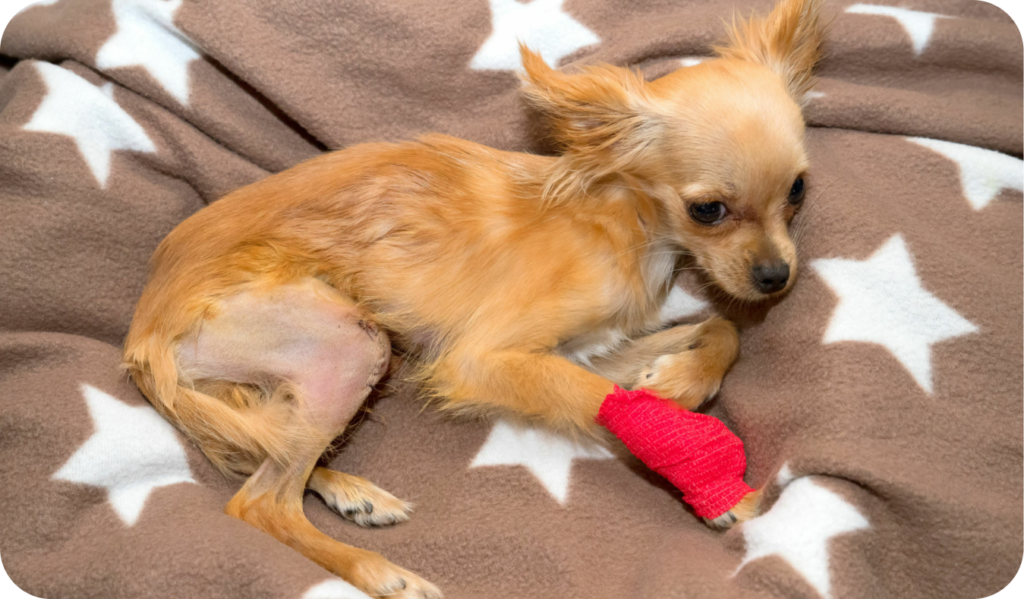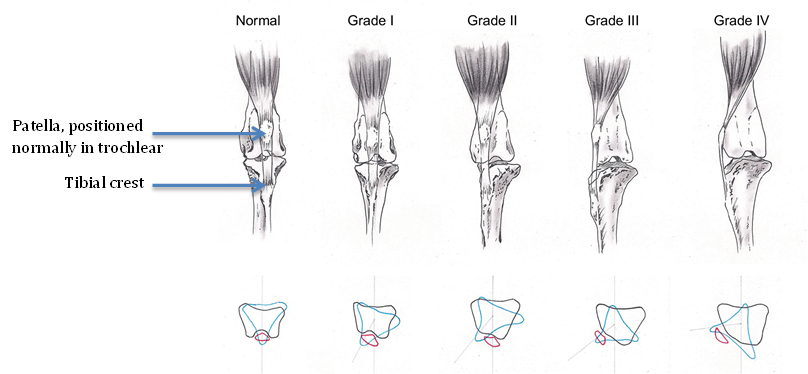Client Resources
Luxating Patellas

The patella ligament is a structure than runs over the cranial aspect (the front) of the stifle joint (knee joint). The patella ligament has a bone — the patella, that most people know as the knee-cap. This ligament and bone track up and down in a V-shaped groove, called a trochlea, from the base of the femur to the tibial crest (the front and top of the shin-bone). The patella and patella ligament form a critical part of normal stifle flexion and extension.
In some individuals, the patella ligaments can move abnormally side to side out over the ridges of its trochlear groove. This is called luxation, and is generally due to abnormal limb conformation. In many cases, the tibial tuberosity (where the patella ligament attaches to the tibia) is positioned too far to one side, which pulls the ligament over the edge of the trochlear groove. In some cases, the trochlear groove may be too shallow, allowing the patella ligament to easily slip over the ridges.
Every time the patella slips over the trochlear ridges, it causes inflammation and abrasion to the cartilage within the joint. Over time, this inflammation can cause pain and result in early-onset arthritis.
As the patella and patella ligament are part of normal knee movement when walking or running, patella luxation causes the knee to be fixed in flexion (bend).
The patella ligament may luxate medially (towards the inside of the leg), or laterally (towards the outside of the leg) depending on the individual’s conformation. Medial patella luxation is much more common than lateral patella luxation. Patella luxation is most common in many small breeds of dog, but can occur in dogs and cats of any size.
There can be a variation is signs based on the severity of the abnormal conformation. Patella luxation is graded 1 to 4, with 1 being very mild and 4 being severe. Grade 1 patella luxations may not show many or any clinical signs. Grade 2s and 3s may show an intermittent limp, hop or skip. Grade 3s are more likely to experience pain when the patella luxates compared to Grade 2s, and will develop arthritis much more quickly. Grade 4s are severely affected and will have a significantly abnormal gait, and have great difficulty straightening their hindlimb.

Treatment and management of patella luxation varies depending on the grade (as mentioned above). Grade 1s and 2s may not require any treatment, or may require conservative treatment such as joint supplements and low/infrequent doses of pain relief. Grade 3s may require pain management more regularly, and are often best treated surgically. Grade 4s can not be treated or managed medically, and must be treated surgically to correct the anatomical abnormality.
Surgery
There are 4 parts of patella surgery; trochleoplasty, tibial tuberosity translocation, medial fascial release, and lateral imbrication.
A trochleoplasty is performed when the trochlear groove is determined to be too shallow. It involves using surgical saws to make the trochlear (the V-shaped groove) deeper, to try to prevent the patella from sliding over the ridges side to side.

Tibial tuberosity translocation is performed when the tibial tuberosity (base attachment of the patella ligament) is positioned too far to one side, and pulls the patella ligament over the ridge of the trochlear. A surgical saw, or a handheld osteotome (similar to a chisel or wedge), is used to carefully cut part of the tibial tuberosity away from the tibia so that it can be repositioned. The tibial tuberosity is fixed back in its new position with surgical wires and pins.

Medial fascial release is performed when the soft tissues that are adjacent to the patella ligament are very tight, and contribute to the patella being pulled to one side. Surgical instruments are used to carefully break down the connection between the soft tissue and the ligament, so they can move independently of each other. Lateral imbrication can be considered as the opposite of a medial fascial release. Lateral imbrication involved suturing the soft tissue on the opposing side so that the patella ligament is held more tightly on the opposing side.
These 4 parts may not all be performed in every patient. The surgical approach for each patient depends on the grade of patella luxation, and the individual anatomy and conformation of the patient. Some patients may only require a tibial tuberosity translocation (TTT). Others may require a TTT and a trochleoplasty. Grade 4 cases often require all 4 parts to achieve good results.
Our recommended heart medication for MVD comes in either a tablet or oral liquid form. It is very important that this medication is be given 30 minutes prior to giving food, as its absorption is affected by the presence of food. Evidence shows that the medication’s effectiveness can be reduced by up to 50% if it is given with food, compared to if given on an empty stomach. For some people, giving medication without food is difficult, so it’s important that we find the right solution for you and your pet.
Patella luxation is the kind of condition that is best treated earlier in the animal’s life, before inflammation and arthritis progresses. That being said, a surgical treatment can be performed at any time. The long-term results are better with earlier intervention. Cases that are Grade 2 or 3 can be treated here in our practice. The cost is $1600-$1700, and includes an overnight stay in hospital, pre-anaesthetic blood testing, post-operative medication, and follow-up visits.
Some Grade 3 cases, and all Grade 4 cases are much more complicated, and should be treated by a specialist orthopaedic surgeon. Referral is easily available, and estimates can be sourced upon request, but the average cost is $3000-$5000.
The most common complications of patella surgery are loosening of implants and infections. Infection can occur in up to 5% of cases, but we take several measures to minimise the chances of infection occurring.
Sometimes the pins implanted after a TTT can loosen over time (weeks to months to years) and may need to be removed later on. This is often a simple procedure, and as long as enough time has passed for new bone to form after a TTT then there are no concerns for bone strength.
Many of the other complications that can occur are results of inappropriate post-operative care. Excessive or unrestricted activity, licking of the surgical site, and inappropriate physiotherapy can lead to joint swelling, persistent lameness, implant failure and, in some cases, fractures at the surgical site. Post-operative care is extremely important, and all efforts should be made to follow the recommendations made by your vet.
While all precautions are taken to ensure that your pet receives the best care possible, no procedure is without risk and sometimes the unexpected can occur. If you have questions regarding anaesthetic or surgical risk for your pet, please speak with our friendly staff.
Each individual patient recovers at a different rate based on age, breed, weight, pre-existing joint disease, and severity of patella luxation before surgery. Generally speaking, the main post-operative recovery period is 8-12 weeks, with the first 4 weeks being the most intense. During the first 4 weeks, your pets must be strictly confined and supervised, so it is important that you have a suitable plan and set-up in place before your pet comes home after surgery.
We recommend crate-resting your pet to minimise excessive activity, with short lead walks outside for toilet breaks. This does mean that a plan for keeping your pet happy during their rest period is needed, known as environmental enrichment. Your vet can give you a detailed recovery plan and advice about managing the initial rest period based on the needs of your pet.

